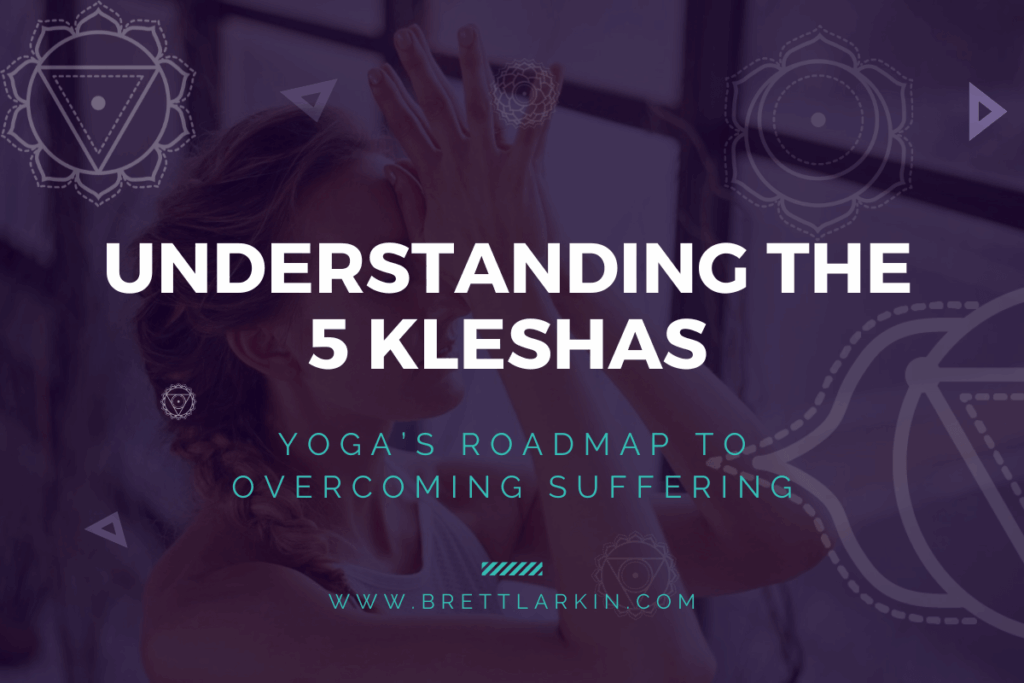
If you’re anything like me, you probably thought the goal of yoga was samadhi—enlightenment, bliss, transcendence. Right?
Well, not exactly.
What if I told you the true aim of yoga is something way more grounded? Something you can actually feel and work with every single day? According to the Yoga Sutras, the real goal of yoga is to dismantle the five kleshas—the root causes of suffering that cloud our perception and pull us out of alignment with who we really are.
Let’s dive deep into these kleshas: how they show up in your everyday life, how they hijack your nervous system, and how the ancient yogis offer practical steps for working with them.
Nerd out with me (in the most embodied, heart-forward way possible).
Listen to this podcast or keep reading for all the details:
What Are the 5 Kleshas in Yoga?

The word klesha means affliction or obstacle. These aren’t just emotional speed bumps—they’re the deep, subconscious distortions that shape how we see the world. And according to Patanjali, they’re the reason we suffer.
Here are the five kleshas:
| Sanskrit Term | Translation | Description |
| Avidya | Ignorance / Wrong Knowing | Mistaking impermanence for permanence or clinging to the physical |
| Asmita | Egoism | Believing our thoughts, roles, or personality are the whole of who we are |
| Raga | Attachment | Clinging to pleasure |
| Dvesha | Aversion | Avoiding pain or discomfort |
| Abhinivesha | Fear of Death / Change | Fear of endings and loss |
The Five Kleshas are the causes of all suffering: craving, aversion, fear of death, egoism, and ignorance. These inner obstacles distort how we perceive the world and ourselves, keeping us stuck in patterns that limit our growth.
Yoga helps us identify and gradually release these obstacles so we can return to our natural state of joy, clarity, and connection to the divine.
The Real Aim of Yoga Isn’t Enlightenment—It’s This
It’s easy to assume that the highest goal of yoga is enlightenment, some far-off transcendent state reserved for saints or sages. But Patanjali’s Yoga Sutras offer us something even more radical and more reachable: clarity.
Sutra 2.2 tells us that the practices of Kriya Yoga—tapas (effort), svadhyaya (self-study), and ishvara pranidhana (surrender)—exist for the purpose of dismantling the kleshas. The work isn’t to chase bliss, but to remove the layers that obscure it because bliss is already within you. Yoga, then, isn’t a path to acquire something new. It’s a process of unlearning, of coming back to what has always been there.
This is where the Eight Limbs of Yoga, introduced later in Book 2, come into play. These eight steps—yamas, niyamas, asana, pranayama, pratyahara, dharana, dhyana, and samadhi—aren’t just a checklist. They’re a roadmap designed to systematically reduce the kleshas and help us see clearly.
The problem, Patanjali tells us, is perception. Like wearing distorted sunglasses, we don’t see clearly. The kleshas are the tint on the lens. Yoga clears the lens. Yoga removes the dot from the lowercase “i” so we can remember our capital “I” nature—pure awareness, unshaken joy.
When we understand this, it becomes clear: the real aim of yoga isn’t some peak experience or moment of arrival. It’s about dissolving the inner barriers—one breath, one thought, one practice at a time—so we can live more fully as the radiant beings we already are.
The Klesha Flowchart: How Suffering Snowballs
But what exactly are these kleshas that contribute to our suffering? Let’s break these down in the order they unfold. Because it’s not a list—it’s a chain reaction.
Experience 3 Training Videos from Inside My 200-Hour Online YTT 👇
1. Avidya (Ignorance)
This is the mama klesha. The root. Not just not knowing, but wrong knowing. Avidya is mistaking the impermanent for permanent, the painful for pleasant, the impure for pure, and the non-self as the true Self.
“If I believe this car, this job, this partner will make me happy forever… that’s avidya.“
Avidya creates the illusion that we are only our mind and body. That illusion births the next klesha…
2. Asmita (Egoism)
Ego isn’t inherently bad—we need a healthy sense of “I” to navigate life. But asmita is when we forget that we are more than our identity, our story, our drop in the ocean. It’s like mistaking the costume for the actor.
“The ego is like a vehicle we drive through life. But we are not the car—we are the one steering it.”
The ego clings to form, limiting our understanding and the way we react to the world around us. The moment the ego is created it forms attachments and aversions, setting the stage for the next two kleshas.
3. Raga (Attachment)
Raga is desire, craving, addiction, and clinging to the things our ego has decided we find pleasurable. The things we think we must have to feel happy. It’s why we reach for the phone, the cookie, the compliment.
“We attach to our desires assuming they will contribute to everlasting happiness. In reality attachment is an obstacle that makes us forget our true nature is bliss.”
4. Dvesha (Aversion)
Dvesha is the other side of the coin. Avoidance of anything that might hurt. Think: social anxiety, perfectionism, or resistance to discomfort. Our ego decides the things we don’t like, that bring us pain or displeasure based on our human experiences, and then tries to get us to avoid them.
“Raga and Dvesha are two ends of the same pendulum, swinging us out of center.”
The ego and the way it leads to our clinging of worldly experiences then contributes to the final klesha…
5. Abhinivesha (Fear of Death)
This one runs deep. It’s not just fear of literal death, but fear of change, endings, impermanence. It’s what keeps us stuck. It’s insecurity over what may or may not happen, anxiety and fear of the unknown. Again, stemming from Avidya.
“Even the wise struggle with this,” says Patanjali (2.9).
The Klesha Scorecard: How Active Are Yours?

Now you’re probably wondering how to tell if your kleshas are overactive or how they’re really impacting your life. Well, in Sutra 2.4, because Patanjali is brilliant, we get a system for grading our kleshas. It’s basically like having a scorecard for how active or weak your kleshas are. Here’s the breakdown:
| State | Description | Example |
| Dormant(Parsupta) | Hidden, not yet expressed | A baby’s unformed preferences |
| Weakened(Tanu) | Present but has little hold | Minimal craving for sugar after long practice |
| Intercepted(Vicchinna) | You are actively working with it | Resisting a desire, but still tempted |
| Active(Udaram) | Controls thoughts/behavior | Outbursts, cravings, identification with the mind |
Let’s make this a little more practical using chocolate cake/sugar as an example. If I’m feeling upset about something and I tell myself “I just need a slice of chocolate cake to make myself feel better” then this klesha of desire(raga) is active. I’m clinging to the idea that the pleasure of sugar will solve my problems. However, having an intercepted klesha would be recognizing that I want the sugar, or cake, to feel good but that it won’t actually make me feel better so I resist the urge to eat it. If this klesha were weakened the desire for the slice of cake may occur to me but it would just be a passing thought. And finally, if it is dormant the thought of reaching for the sugar would not even occur to me.
What does this look like in your life? Try journaling: Which kleshas show up most often for you? What state are they in?
How to Dismantle the Kleshas (According to the Yoga Sutras)

Once we recognize the kleshas, how do we actually work with them? Patanjali gives us two primary techniques depending on the strength of the klesha in the moment.
If the klesha is subtle or weakened, Sutra 2.10 tells us it can be dissolved by returning it to its original cause—ignorance or misidentification. In other words, if you’re already aware of a pattern and it doesn’t have a tight grip on you, self-study, meditation, and remembrance of your true nature can help dissolve it. This is what I lovingly refer to as the “lightsaber approach”—you cut through the klesha with insight and inner clarity. You remember: Oh wait, I’m not the car—I’m the driver.
But what if the klesha is really strong? What if you’re in the middle of a craving, a fear spiral, or totally lost in an egoic narrative?
That’s where Sutra 2.11 steps in. Here, Patanjali recommends dhyana—meditation—as the antidote. Not because it makes the problem vanish, but because it gives your mind something else to focus on. So instead of obsessing over a slice of cake or future worst-case scenarios, you gently shift your attention to mantra, breath, or a candle flame. Satnam > Cake is not a joke—it’s a real and practical application.
In the podcast, I shared that if your klesha is strong, trying to analyze it or out-philosophize it won’t help. You’re too entangled. That’s why Patanjali offers this tiered approach:
- When a klesha is faint—go deep.
- When a klesha is loud—go simple.
And both are yoga.
Micro Practice: From Wrong Knowing to Right Seeing
Let’s land all this philosophical brilliance into your body. This simple practice invites you to observe your own filters—the stories, attachments, or habits that might be rooted in wrong knowing. It’s not about fixing anything. It’s about noticing.
Find a quiet seat. Bring your awareness to your breath. Soften your gaze or close your eyes.
Ask:
- What am I mistaking as permanent that is actually fleeting?
- Where am I clinging to something that once felt good but no longer serves?
Notice what arises. Don’t force answers. Let them bubble up like images in a dream.
Repeat softly, like a lullaby to your nervous system:
“I am not the thought. I am the one who sees.”
Final Thoughts: Kleshas Are a Mirror, Not a Mistake
You don’t need to be perfect to be free. The kleshas aren’t your fault—they’re your curriculum. Your yoga practice isn’t about eliminating them overnight. It’s about softening, seeing, shifting.
Even awareness of the kleshas is progress. Even noticing the distortion is a sign of awakening.
So be gentle with yourself. Keep coming back to the capital “I.”
And if you’re craving more structure and support on this journey, this is exactly the kind of transformational inner work we dive into inside my Yoga for Self-Mastery course. This self-paced program is designed for yogis and seekers who want to explore their inner world, build emotional resilience, and embody yogic wisdom in everyday life. Whether you’re a teacher or a student, this course helps you dismantle the kleshas in real time—not just with theory, but through practice, reflection, and real-life application.
FAQ: Common Questions About the Kleshas
Can I ever get rid of the kleshas completely?
Not likely. Even the wise are impacted by abhinivesha (2.9). But you can reduce their grip and live with more freedom and discernment.
Which klesha is the most dangerous?
One is not more “dangerous” than any other. All the kleshas contribute to suffering. However Avidya, wrong knowing, is the root of all the others making it the strongest among them.
What yoga practices help most with the kleshas?
Kriya Yoga: tapas (effort), svadhyaya (self-study), and isvara pranidhana (surrender).
Want more? Listen to the full episode [“Dismantling the Kleshas”] above and explore these teachings inside the Uplifted Yoga Teacher Training or Yoga for Self Mastery programs. We go way deeper than the blog.
From my heart to yours, Brett ✨
Next Steps
- Take my History of Yoga Course to learn all about yogic principles and how they are applied to daily life!
- Order my Yoga Life book for a practical guide to applying yogic principles to your life and constitution.
- Check out my Yoga Philosophy knowledge hub for more inspiring content
- Join Uplifted for exclusive content that you can access right from the app. Take a deep dive into your practice with me this year!
Experience 3 Training Videos from Inside My 200-Hour Online YTT

YOU MIGHT ALSO LIKE
- What is Kriya Yoga? The Philosophy and Practice
- Uddiyana Bandha: Tapping Into Your Deep Core
- 4 Reasons Hasta Bandha Is Essential To Your Yoga Practice
- Vitarka Mudra: What It Is and How Do You Use It?
- Shakti Mudra: What It Is and How Do You Do It?
- Garuda Mudra: What It Is and How Do You Use It?
- Kali Mudra: What It Is and How Do You Do It?
- Shunya Mudra: What It Is and How Do You Do It?
- Varuna Mudra: What It Is and How Do You Use It?
- Vayu Mudra: What It Is and How Do You Use It?
- Samana Vayu: The Energy of Balance & How to Access It
- Apana Vayu: The Energy of Release & Surrender
- Udana Vayu: The Ascending Wind
- Prana Vayu: The Breath of Vitality
- Vyana Vayu: The Energetic Secret to Flow












